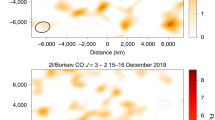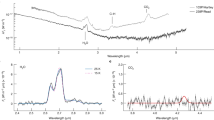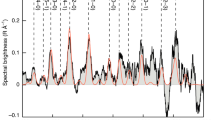Abstract
WHEN comet C/1995 Ol (Hale–Bopp) was discovered1, at a distance of seven astronomical units from the Sun, it was more than one hundred times brighter than comet Halley at the same distance. A comet's brightness is derived from the reflection of sunlight from dust grains driven away from the nucleus by the sublimation of volatile ices. Near the Sun, sublimation of water ice (a main constituent of comet nuclei) is the source of cometary activity; but at its current heliocentric distance, Hale–Bopp is too cold for this process to operate. Other comets have shown activity at large distances2, and in the case of comet Schwassmann–Wachmann1, carbon monoxide has been detected in quantities sufficient to generate its observed coma3,4. Here we report the detection of CO emission from Hale–Bopp, at levels indicating a very large rate of outgassing. Several other volatile species were searched for, but not detected. Sublimation of CO therefore appears to be responsible for the present activity of this comet, and we anticipate that future observations will reveal the onset of sublimation of other volatile species as the comet continues its present journey towards the Sun.
This is a preview of subscription content, access via your institution
Access options
Subscribe to this journal
Receive 51 print issues and online access
$199.00 per year
only $3.90 per issue
Buy this article
- Purchase on Springer Link
- Instant access to full article PDF
Prices may be subject to local taxes which are calculated during checkout
Similar content being viewed by others
References
Hale, A. & Bopp, T. IAU Circ. No. 6187 (1995).
Huebner, W. F. et al. (eds) Workshop on the Activity of Distant Comets (Southwest Research Inst., San Antonio, 1992).
Senay, M. S. & Jewitt, D. Nature 371, 229–231 (1994).
Crovisier, J. et al. Icarus 115, 213–216 (1995).
Wild, W. The 30m Manual: a Handbook for the IRAM 30m Telescope (IRAM, Granada, 1995).
Rauer, H. et al. IAU Circ. No. 6236 (1995).
Matthews, H. E., Jewitt, D. & Senay, M. C. IAU Circ. No. 6234 (1995).
Womack, M., Stern, S. A. & Festou, M. C. IAU Circ. No. 6276 (1995).
Bockelée-Morvan, D., Crovisier, J. & Gérard, E. Astr. Astrophys. 238, 382–400 (1990).
Despois, D. et al. Planet. Space Sci. (in the press).
Kidger, M. et al. IAU Circ. No. 6240 (1995).
Crovisier, J. Astr. Astrophys. Suppl. Ser. 68, 223–258 (1987).
Jewitt, D. Astrophys. J. 351, 277–286 (1990).
Fulle, M. Nature 359, 42–44 (1992).
Colom, P. et al. Astr. Astrophys. 264, 270–281 (1992).
Bockelée-Morvan, D. et al. Astr. Astrophys. 287, 647–665 (1994).
Crovisier, J. in Asteroids, Comets Meteors 1993 (eds Milani, A. et al.) 313–326 (Kluwer, Dordrecht, 1994).
A'Hearn, M. F., Haken, M. & Feldman, P. D. IAU Circ. No. 6244 (1995).
Fitzsimmons, A. & Cartwright, I. M. Mon. Not. R. astr. Soc. 278, L37–L40 (1996).
A'Hearn, M. F. et al. Astr. J. 89, 579–591 (1984).
Davies, J., Geballe, T., Owen, T. & de Bergh, C. IAU Circ. No. 6225 (1995).
Author information
Authors and Affiliations
Rights and permissions
About this article
Cite this article
Biver, N., Rauer, H., Despois, D. et al. Substantial outgassing of CO from comet Hale–Bopp at large heliocentric distance. Nature 380, 137–139 (1996). https://doi.org/10.1038/380137a0
Received:
Accepted:
Issue Date:
DOI: https://doi.org/10.1038/380137a0
This article is cited by
-
Identification of two sources of carbon monoxide in comet Hale–Bopp
Nature (1999)
-
Hale–Bopp looks like a winner
Nature (1996)
-
Eruptions of comet Hale-Bopp at 6.5 AU
Astrophysics and Space Science (1996)
Comments
By submitting a comment you agree to abide by our Terms and Community Guidelines. If you find something abusive or that does not comply with our terms or guidelines please flag it as inappropriate.



